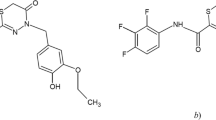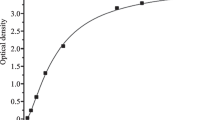An HPLC-MS method for simultaneous quantitative determination of a novel gestagenic pharmaceutical and two of its metabolites in rat and rabbit blood sera was developed and validated. The method was selective and specific. The detection limit for all analytes was 5 ng/mL; lower limit of quantitation, 10 ng/mL. Calibration curves for all analytes had the form y = ax + b. The correlation coefficients were >0.99. Matrix effects, degree of extraction, and stability of analytes in standard solutions, analytical samples, and the biomatrix with multiple freeze—thaw cycles were studied.
Similar content being viewed by others
Avoid common mistakes on your manuscript.
Preclinical pharmacokinetics studies are essential to the development of drugs based on a new pharmaceutical [1, 2] and require quantitative determination of the test compound in the blood pool [3]. In several instances, a handbook established the need for quantitative analysis of the drug biotransformation products [3]. The goal of the present work was to develop and validate an HPLC-MS method for simultaneous quantitative determination of three analytes, i.e., the drug and two of its metabolites, in the framework of pharmacokinetics studies of the innovative gestagen steroidal Gestobutanoyl tablets (0.002 g) for hormonal replacement therapy of gestagenic deficiency [4, 5].
The steroid molecules were relatively nonpolar, which made them difficult to detect by mass spectrometry. The specifics of using chemical ionization rather than electrospray ionization for similar compounds were discussed in the literature [6, 7]. The two ionization methods were compared by us with chemical ionization being selected for further work.
The HPLC-MS method was fully validated using rat blood serum for selectivity, linearity, precision, accuracy, and stability of analytes in the matrix, analytical samples, and standard solutions. Matrix effects and the degree of extraction were studied. The selectivity, linearity, precision, and accuracy were reproduced for rabbit blood serum. As a result, the developed HPLC-MS method was suitable according to all validation parameters for simultaneous quantitative determination of gestobutanoyl and its metabolites in blood sera of experimental animals.
Experimental Part
The following drug substances were used in the work: 17-acetoxy-3β-butanoyloxy-6-methylpregna-4,6-dien-20-o ne (GB, batch 280917, ≥ 99.0% by HPLC); 17-acetoxy-3β-hydroxy-6-methylpregna-4,6-dien-20-one (AMP-17), an intermediate in the synthesis of GB (≥ 99.0% by HPLC), supplied by N. I. Pirogov RNRMU, Molecular Pharmacology Research Laboratory directed by Dr. N. L. Shimanovskii; and 17-hydroxy-6-methyl-4,6-pregadien-3,20-dione-17-acetate (MA) (Sigma, USA).
The studies used an Ultimate 3000 HPLC (Dionex, Germany) with a MicrOTOF-Q II mass detector (Bruker, Germany).
Biological samples were obtained from two experimental animal species, i.e., female rats (200 ± 60 g) and female rabbits (3.0 ± 0.2 kg) (Stolbovaya Nursery, Chekhov). The basic conditions for care and handling complied with SP 2.2.1.3218-14 dated Aug. 29, 2014 No. 51; GOST 33044-2014; and Ministry of Health Order No. 199n dated Apr. 1, 2016.
Biological samples were taken from untreated animals. Rat blood was obtained by decapitation; rabbit, from an ear-vein catheter.
HPLC separation used a Thermo Scientific Acclaim 300-C18 column (2.1 × 150 mm) and mobile phases H2O (phase A) and MeCN (phase B) at flow rate 0.3 mL/min in gradient mode at times (min): 0.0 → 8.0 → 8.2 → 14.0 → 14.2 → 20.0; phase A (%): 50 → 50 → 10 → 10 → 50 → 50; phase B (%): 50 → 50 → 90 → 90 → 50 → 50.
The total analysis time was 20 in. The injected sample volume was 20 μL. The retention times under these conditions were AMP-17, 8.6; MA, 10.2; and GB, 16.2 min.
Mass detection used chemical ionization in positive-ion mode at source temperature 210°C, vaporizer temperature 400°C, capillary potential 4,000 V, corona discharge 4,000 nA, and N2 as spray (2.5 bar) and drying gas (4.5 L/min). The target ions for AMP-17 and GB were fragments of [M + H]+ with m/z 309.2. MA was recorded as the protonated molecule [M + H]+ with m/z 385.2.
Six matrix solutions were prepared for the work. These were two solutions of each analyte in MeCN (LabScan, Poland). The concentration of the GB and AMP-17 matrix solutions was 0.1 mg/mL; of MA, 1 mg/mL. Some analyte solutions were used to prepare standard solutions for calibration standards; others, standard solutions for quality control (QC) samples.
Standard solutions were prepared so that one solution contained all analytes at the required concentrations. The concentration range 10 – 1,000 ng/mL was selected for the calibration curves for GB and AMP-17; 10 – 5,000 ng/mL, for MA. The first-level quality control sample (QC1) of each analyte corresponded to its lower limit of quantitation (LLOQ, 10 ng/mL). The other QC samples (Q2, Q3, Q4) for GB had concentrations 25, 600, and 750 ng/mL; for AMP-17, 30, 500, and 750 ng/mL; for MA, 25, 2,500, and 3,750 ng/mL. Standard solutions of analytes were prepared by sequential dilution in MeCN.
Preparation of model plasma. Calibration standards and QC samples were prepared by adding standard solution (30 μL) of the appropriate concentration to blood serum (170 μL). Blank samples were prepared by adding MeCN (30 μL) to blood serum.
Sample preparation. An aliquot of animal blood serum 200 μL) was treated with MeCN (400 μL) and centrifuged at 3,000 rpm for 5 min in a Centrifuge 5425 (Eppendorf, Germany) to separate coagulated proteins. The supernatant was analyzed.
Matrix effects and the degree of extraction were studied using two types of samples, i.e., aqueous reference solutions and reference standards. The aqueous reference solutions were prepared in the same manner as the calibration standards except that H2O was used instead of blood serum. The reference standards were prepared by 1:20 dilution of standard analyte solutions with supernatant obtained from the blank serum sample.
Results and Discussion
Comparison of APCI and ESI mass spectra of analytes. Two ionization sources, i.e., electrospray (ESI) and chemical (APCI), were compared during method development. Various mass spectrometer tunings and additives to the mobile phase were used to achieve the maximal method sensitivity. Figure 1 shows typical ESI mass spectra of GB, AMP-17, and MA.
Figure 1 shows that GB and AMP-17 did not form molecular ions [M + H]+ with m/z 457.2 and 386.2, respectively, if ESI was used. The cation adducts [M + Na]+ and [M + K]+ were formed with the former dominating the spectra. Cation adducts in ESI are unsuitable for stable and reproducible quantitative analysis because cations must be added to the mobile phase. This can degrade the sensitivity and reproducibility of the results. If cations are not added to the mobile phase, the ionization can shift toward formation of some ions or others (including cation adducts), which affects the reproducibility of the spectrum in general.
In addition, APCI gave MS spectra for all three analytes without cation adducts. The target ion for MA using either ionization mode was [M + H]+ with m/z 385.2. APCI spectra of GB and AMP-17 were missing [M + H]+ ions. Fragments with m/z 309.2 that were formed in the ionization source were dominant. The same target ion for the two analytes was allowed because GB and AMP-17 had different retention times in the chromatography sample.
APCI was selected as the ionization source based on the results because it enabled the simplest mobile phase to be used to determine simultaneously and reliably, qualitatively and quantitatively, all three analytes.
Selectivity, detection limit, lower limit of quantitation. An analysis of several rat and rabbit blood serum blanks and a comparison with samples containing all three analytes showed that the developed method was highly selective. Endogenous compounds did not interfere with determination of the analytes.
The detection limit for all analytes was 5 ng/mL; LLOQ, 10 ng/mL (Fig. 2).
Calibration curves. Six calibration standards prepared in rat blood serum were analyzed three times each. Calibration curves for GB, AMP-17, and MAwere linear with correlation coefficients r > 0.998. The linear dependences (r > 0.995) of detector response to concentration of each analyte in the analyzed samples were reproduced in rabbit serum (Table 1).
Deviations from the nominal concentration were less than the allowed values (20% for LLOQ and 15% for other standards) for all calibration standards.
Accuracy and precision. Deviations of intra- and inter-day accuracy and precision were % (20% for LLOQ) in rat blood serum. The accuracy and precision of the method in rabbit blood serum was confirmed using a series of QC samples.
Degree of extraction and matrix effects were studied at two concentration levels using QC2 and QC3 standard solutions.
Matrix effects were defined by a matrix factor (MF) expressed as the ratio of analyte chromatographic peak areas in reference standards and aqueous reference solutions. The MFs for low (QC2) and high (QC3) analyte concentrations were practically the same and averaged 1.0, 1.1, and 1.2 for GB, AMP-17, and MA, respectively. The MF values were close to unity and indicated insignificant matrix effects.
The degree of extraction (DE) was calculated as the ratio of analyte peak areas in QC samples and reference standards. he DE for GB was 45.8 and 65.1% for QC2 and QC3, respectively; for AMP-17, 78.7 and 80.3%; for MA, 83.7 and 88.7%.
Stability. The analytes were demonstrated to be stable in the matrix, i.e., rat blood serum, with multiple freeze—thaw cycles. The stability of the analytes in analytical samples stored in the autosampler at 10°C for 16 h and in standard solutions at ambient conditions was studied. Table 2 presents the results.
The difference between the first and repeated analyses was % in all stability studies. Thus, the method was validated according to requirements of the Handbook for Drug Review [8].
References
RF Ministry of Health Order No. 409-n dated Jul. 12, 2017 “On the Approval of a Procedure for Forming the Registration Dossier for a Pharmaceutical and Documentary Requirements in the Dossier, Requirements Regarding the Scope of Information to Be Provided as Part of the Registration Dossier for Certain Types of Pharmaceutical Drugs and the Procedure for Submitting Documents from which the Registration Dossier for a Pharmaceutical Drug is Formed for the Purpose of its State Registration” [in Russian], Sec. 5, Moscow (2017).
R. D. Syubaev, G. N. Engalycheva, D. V. Goryachev, et al., Khim.-farm. Zh., 52(9), 3 – 7 (2018); Pharm. Chem. J., 52(9), 753 – 757 (2018).
A. N. Mironov (ed.), Handbook for Preclinical Drug Studies [in Russian], Part 1, Grif i K, Moscow (2012).
P. V. Sergeev, T. A. Fedotcheva, V. M. Rzheznikov, et al., Vestn. Ross. Akad. Med. Nauk, No. 5, 27 – 32 (2007).
T. A. Fedotcheva and N. L. Shimanovskii, Probl. Endokrinol., 64(1), 54 – 61 (2018).
Y.-C. Ma and H.-Y. Kim, J. Am. Soc. Mass Spectrom., 8, 1010 – 1020 (1997).
R. Wang, L. Zhang, Z. Zhang, et al., J. Pharm. Anal., 6, No. 6, 356 – 362 (2016).
A. N. Mironov (ed.), Handbook for Drug Review [in Russian], Vol. 1, Grif i K, Moscow (2013).
Acknowledgments
The article was prepared in the framework of State Contract No. 19.12597.2018/12.1, Ministry of Education and Science, Russian Federation, Review of Application Content, Reports, and Results for the State Program “Development of the Pharmaceutical and Medical Industries in 2013 – 2020” and in the framework of existing obligations for the Federal Targeted Program “Development of the Pharmaceutical and Medical Industries of the Russian Federation up to 2020 and Further Prospects.”
Author information
Authors and Affiliations
Corresponding author
Additional information
Translated from Khimiko-Farmatsevticheskii Zhurnal, Vol. 52, No. 12, pp. 55 – 59, December, 2018.
Rights and permissions
About this article
Cite this article
Stepanova, E.S., Makarenkova, L.M., Chistyakov, V.V. et al. HPLC-MS Method for Simultaneous Quantitative Determination of an Innovative Russian Gestagen and its Metabolites in Rat and Rabbit Blood Sera. Pharm Chem J 52, 1016–1020 (2019). https://doi.org/10.1007/s11094-019-01944-x
Received:
Published:
Issue Date:
DOI: https://doi.org/10.1007/s11094-019-01944-x






